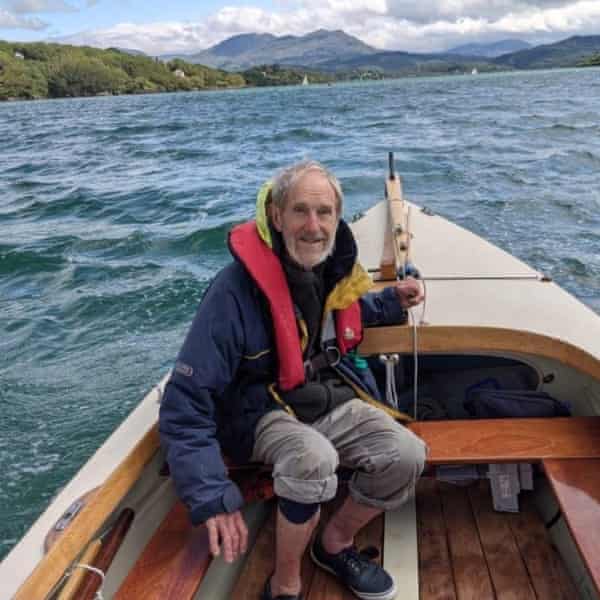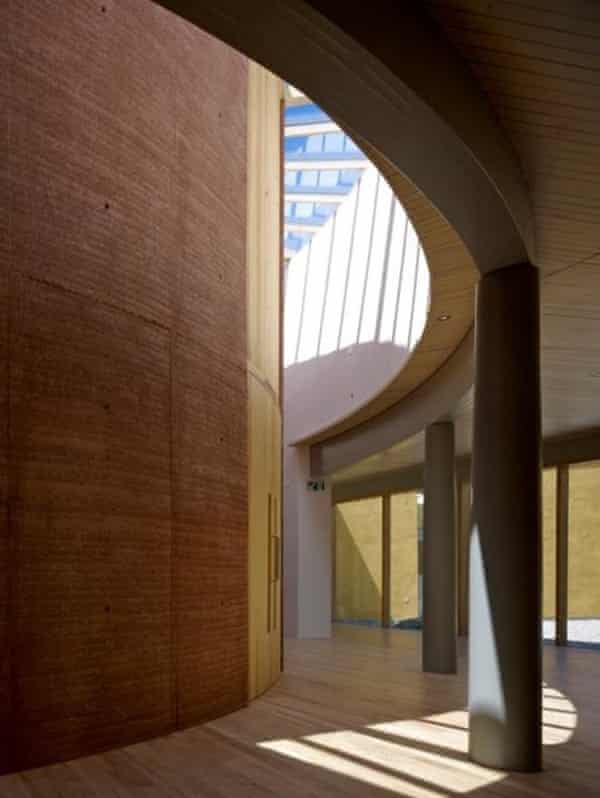Building beautiful places in a way that takes advantage of all that nature provides, while at the same time causing minimal harm to it, is what propelled the architect David Lea, who has died aged 82. His output was not prolific but each project, whether built or unbuilt, demonstrated his determination to create low-impact buildings – at one with the natural world rather than at odds with it.
As Lea himself said: “When we build we reveal our vision of the future. One moment the design is inside our heads, the next it is grounded in all its solid reality. This imposes a responsibility which is impossible to avoid. Our vision surely must include the truth of rapidly accelerating climate change and the imperative to preserve the natural habitats of all the creatures with whom we share the Earth.”
Lea’s last major project, which epitomised this philosophy, and the crowning glory of a career that began around 1965, is the Wales Institute for Sustainable Education (Wise) building at the Centre for Alternative Technology, near Machynlleth in mid-Wales (2007-10). Designed with the architect Pat Borer, it comprises residential and teaching accommodation, restaurant and workshops, and a circular auditorium enclosed by a seven-metre-high wall of rammed earth. Interspersed among the parts of the building are pools of water, paved terraces and timber-slatted access galleries. It feels more like a Mediterranean hill town than the damp slate quarry reclaimed by the centre when it was established in 1973.
The building is made largely from natural products, with timber and limecrete for its structure and walls of lime-rendered hempcrete brightly coloured with limewash. Whatever the weather, the inside spaces are in constant dialogue with the outside, through large sliding windows or carefully positioned zen peepholes, or the oculus that lights the auditorium.

Lea’s first important work, which brought him to national attention, was a sheltered housing scheme at Churt, Surrey, built between 1968 and 1991. He designed the early phases following the constructional principles of Walter Segal, who developed a system of easily built timber details that avoided wasteful cutting. In later phases, the influence was more from Japan (which Lea visited in 1975), with a move from bolted joints and boards to carpentry joints and lime-rendered wall finishes.
Lime render and locally quarried stone were the chief ingredients for his projects at the Royal Agricultural College (now Royal Agricultural University), Cirencester: a modest library extension (1981) and two phases of student housing (1982 and 1991), both inspired by the vernacular of traditional Cotswold buildings.
A tiny studio for an artist in Somerset (1989) surprises yet again. With hardly a straight line or right angle, Lea appears to have moved into an organic, Steiner-inspired world, but its construction is a functional response to the saplings he found when searching for a source of structural timber. All these projects share a similar quality of serenity and simplicity, despite their different palettes and appearance.
A modest supply of private houses and small community buildings occupied Lea through the 80s and 90s, together with a succession of competitions for new buildings at Oxbridge colleges; however it is surely a missed opportunity for both Oxford and Cambridge that not one of these seven projects went ahead.
Born in Edgbaston, Birmingham, to Betty (nee Rosher), a piano teacher, and Ian Lea, a stockbroker, David had a happy and conventional upbringing. It was family holidays in Scotland that inspired in him a love of the natural world, and it was his art teacher at his school, Clifton college, in Bristol, who suggested he become an architect.
In 1958 he went to Pembroke College, Cambridge, to study architecture under the recently appointed Leslie Martin, with Colin St John Wilson and Colin Rowe two of his most influential teachers.
He sailed in a yacht to the US to do his year-out with Harry Weese in Chicago, then, after completing the diploma course back in Cambridge, worked for a short time with Wilson. He moved to London in 1966, where he designed housing for the London borough of Merton.
Before finishing at Merton, a cousin had approached him to design the Churt project and he was able to go solo. It was also around this time that he became increasingly restless with his life in London. A study trip in 1975 to Mao’s China confirmed political and social ideas already forming in his head. At a talk he gave on his return, he stated: “Three impressions remain clearly in my mind: the extraordinary intensity of the agriculture, the absence of the negative effects of poverty within a basically poor country, and the great gentleness of the people towards each other … China makes one think very hard principally about the balance between one’s own needs and the needs of society.”

Holiday trips to a stone cottage in Snowdonia and the rise of the back-to-the-earth movement convinced him that he should move. After six months learning techniques with the self-sufficiency pioneer John Seymour in Pembrokeshire, Lea moved to Ogoronwy, a smallholding in the hills above Porthmadog, Gwynedd.
The balance of his new life changed constantly. If there were no clients to serve, he turned his attention to rebuilding his outbuildings and working the smallholding. If the office became busy, the land could look after itself, although, with the help of assistants, work on all fronts was always possible. Indeed, it was Lea’s ideal to live a varied and integrated life, cultivating the land for his family’s daily needs, designing buildings for sympathetic clients who would share his environmental ideals and, when he had time, indulging in his passion for sailing.
Rumblings about the fragility of the planet had begun to be heard in the 70s. Lea was among the few who took heed and altered their lives accordingly. Half a century later, the environmental crisis has become critical. Now is the time to take better notice of the principles Lea so fervently followed throughout his remarkable life.
He is survived by his partner, Sylvia Harris, his children, Trystan and Teleri, from his marriage to Awel Irene, which ended in divorce, and by his sister, Fiona.